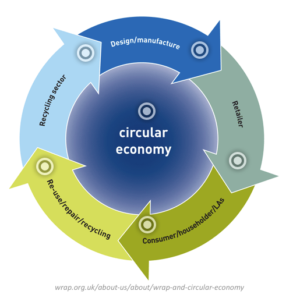Going beyond the 3Rs of waste.
Imagine this: You’re at a gathering of friends. It’s a lively group filled with laughter, wine, and banter. When you get home, you find a large wine stain on your shirt. With a sigh of resignation, you toss the shirt into the trash. A day later, it’s on its way to a landfill.
Eventually your shirt will end up as one piece among the 13 million tons of clothing added to U.S. landfills each year. That’s about 3,550,000 tons a day, or the equivalent of about 507,000 male elephants. (A large male elephant is about 7 tons.) You personally are likely to contribute over 80 pounds of clothing to the pile.
As long as the population keeps growing. As long as fast fashion remains in vogue. As long as behavior remains as it is. These numbers will keep rising.

Perhaps it’s time to take a page from a model gaining traction in the EU, the Circular Economy — “an alternative to a traditional linear economy (make, use, dispose) in which we keep resources in use for as long as possible…and then recover and regenerate products and materials at the end of each service life.”
A circular economy isn’t just another name for reduce-reuse-recycle. It involves managing the supply chain of products to “reduce reliance on virgin materials.” For example, in a circular economy, instead of throwing away textile scraps, they would be used to make swim trunks. Instead of tossing auto floor mats, the nylon in the fiber would be used to make covers for engine parts.
Earlier this year, French President Macron announced a Circular Economy Roadmap. The goals of the roadmap, soon to be announced in a policy paper, are to reduce resource consumption, landfill waste, and greenhouse gas emissions while increasing plastic recycling and creating new jobs and businesses. Working in concert with the European Union’s Circular Economy Action Plan, the focus is on “‘closing the loop’ of product lifecycles through greater recycling and re-use.”
For French fashion and textile industries, this means not destroying or throwing out unsold goods. Not sending goods to landfills. Not using them as fuel (which has been done). It means donating them. Repurposing them. Recycling them…as national policy.
It’s time for our own fashion professionals to follow issues like these, generate support for them in the States, and lobby our congressional representatives. Pushing for business incentives that reduce the quantity of merchandise going to landfills would be a good start.
This might be one time when a circular argument will actually take us where we need to go.

At a recent presentation in Newport (RI) as the Volvo Ocean Sailors had a stopover, they offered up REFUSE as the first step in the cycle, as in REFUSE to purchase items packaged in one-use plastic, (and many others). The last step is “REQUEST” (which really means Demand, but it doesn’t start with R!) – so, REQUEST our government to do more – much more – in reducing the waste we create.
There shouldn’t be any landfills then this problem is gone. Throw away what you will. There is the proper Waste To Energy in place and working in some countries to go in, recycle what is recyclable take the solid waste and turn it into burnable brickets that produce syngas with almost zero emissions while creating energy. There is also the technology available to then go in and completely clean up the contamination from the landfill. At that point all garbage collected goes right to the WTE plant to be turned into energy. Guess what you cant do this in any state in the country because companies like Covanta have the contracts to steam and burn the garbage like on Long Island. Corruption is the main problem here and it doesn’t have a political party. Its just corruption on a massive scale.
Great article! We are working on regenerating rugs from used sheets …. Also few other corporates working their way toward this model (Eileen Fisher) being most prominent.
Thank you! You’re certainly engaged in interesting and important work toward the circular economy. Yes!!